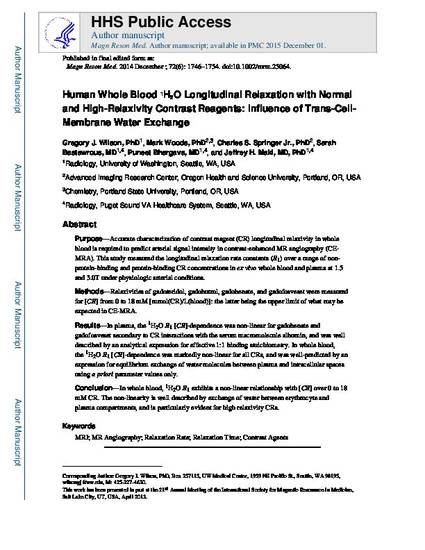
- Magnetic resonance imaging,
- Angiography,
- Contrast-enhanced magnetic resonance imaging,
- Arteries -- Magnetic resonance imaging,
- Contrast media (Diagnostic imaging)
PURPOSE: Accurate characterization of contrast reagent (CR) longitudinal relaxivity in whole blood is required to predict arterial signal intensity in contrast-enhanced MR angiography (CE-MRA). This study measured the longitudinal relaxation rate constants (R1 ) over a concentration range for non-protein-binding and protein-binding CRs in ex vivo whole blood and plasma at 1.5 and 3.0 Tesla (T) under physiologic arterial conditions.
METHODS: Relaxivities of gadoteridol, gadobutrol, gadobenate, and gadofosveset were measured for [CR] from 0 to 18 mM [mmol(CR)/L(blood)]: the latter being the upper limit of what may be expected in CE-MRA.
RESULTS: In plasma, the 1H2 O R1 [CR]-dependence was nonlinear for gadobenate and gadofosveset secondary to CR interactions with the serum macromolecule albumin, and was well described by an analytical expression for effective 1:1 binding stoichiometry. In whole blood, the 1H2 O R1 [CR]-dependence was markedly non-linear for all CRs, and was well-predicted by an expression for equilibrium exchange of water molecules between plasma and intracellular spaces using a priori parameter values only.
CONCLUSION: In whole blood, 1H2 O R1 exhibits a nonlinear relationship with [CR] over 0 to 18 mM CR. The nonlinearity is well described by exchange of water between erythrocyte and plasma compartments, and is particularly evident for high relaxivity CRs.

This is the author’s version of a work that was accepted for publication in Magnetic Resonance in Medicine. Changes resulting from the publishing process, such as peer review, editing, corrections, structural formatting, and other quality control mechanisms may not be reflected in this document. Changes may have been made to this work since it was submitted for publication. A definitive version was subsequently published in Magn. Reson. Med., 72: 1746-1754. doi:10.1002/mrm.25064